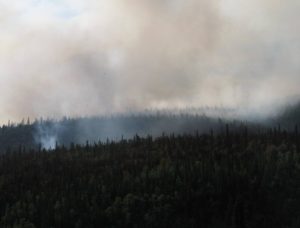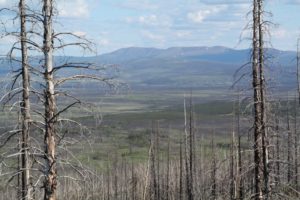
Smoke from a forest fire in an Alaskan boreal forest near Bonanza Creek LTER
Credit: JIll Johnstone, BNZ LTER
As boreal forest wildfires increase in severity and frequency, new patterns of post-fire recovery are emerging. Research led by Jill Johnstone at Bonanza Creek LTER has found that recent wildfires led to changes in tree species dominance that are persisting through post-fire succession in Alaskan boreal forests, indicating the potential for a widespread shift in vegetation to alternative stable states.
Black spruce forests have historically been sustained by stabilizing feedbacks with past fire cycles, but early recovery trends from more recent fires suggest this stable state may shift to alternative deciduous or mixed forests. Because Alaskan black spruce forests interact with climate through several pathways, shifts in tree dominance could have both local and global implications, including changes to carbon and nutrient cycling, fire behavior, albedo, permafrost stability, and net ecosystem carbon balance, and thus have the potential to either warm or cool the atmosphere. However, to accurately model the direction and magnitude of the effect of future shifts on climate, scientists need better predictions of where state changes will occur.
To assess whether initial conditions can be used to predict long-term trajectories and to better understand drivers behind state change, Johnstone et al. tracked post-fire succession across 89 sites for a span of 13 years following a widespread fire season in Interior Alaska. Recovery patterns observed two years post-fire were the strongest predictors of canopy dominance 13 years later. In previous localized studies deciduous tree seedlings were outcompeted by shrubs and susceptible to browsing. In contrast, this landscape-scale study found no effect of these biotic interactions on seedling density or biomass. Instead, fire severity interacted with environmental conditions and allowed deciduous tree seedlings, such as aspen and birch, to successfully establish and outgrow the more conservative black spruce seedlings.

A boreal forest near Bonanza Creek LTER after a fire.
Credit: Jill Johnstone, BNZ LTER
Johnstone et al. hypothesized that higher severity burns decreased organic layer depth and increased soil nutrient cycling—two factors that improve deciduous seedling recruitment and biomass. Furthermore, severe burning tended to occur at better drained, low elevation sites, where deciduous seedlings have a growth advantage over black spruce. Once established, the study indicates new deciduous dominance of the canopy is likely to persist. Not all stands, though, were replaced with deciduous or mixed forests. Black spruce dominance reestablished in 29% of sites by the end of the study, primarily at sites with higher soil moisture, higher elevation, and a deeper soil organic layer.
As an intensified fire regime threatens to transform boreal black spruce forests, this research suggests initial patterns that emerge post-fire could be used to forecast forest composition and create what Johnstone refers to as “intentional interventions” for future mediation.
Additionally, as changes in climate alter disturbance regimes across the globe, this study offers an important take-away for future dynamics of stable states in other forested ecosystems. “Even apparently stable forests can change dramatically and rapidly with severe disturbances,” cautions Johnstone. She emphasizes it was the collection of long term data, including the collaborative support behind this study, that allowed the research team to draw these broader conclusions on post-disturbance succession.
—Haley Dunleavy
Johnstone, J. F., Celis, G., Chapin III, F. S., Hollingsworth, T. N., Jean, M., & Mack, M. C. (2020). Factors shaping alternate successional trajectories in burned black spruce forests of Alaska. Ecosphere, 11(5), e03129. doi: 10.1002/ecs2.3129










